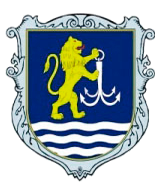ПОШУК БЕЗПІЛОТНИМИ ЛІТАЛЬНИМИ АПАРАТАМИ ПЛАВАЮЧИХ МІН МЕТОДАМИ КІНЕМАТИЧНОГО ПРОЕКТУВАННЯ
Abstract
The issue of demining sea raids and ports, which is relevant for Europe during the period of active deployment of military confrontations on its territory, is considered. It is proposed to combine the search capabilities of unmanned aerial vehicles with the ability to clear floating mines of trawler boats. The optimal trajectory of search movements of aircraft along the Archimedean spiral is proposed. An appropriate number of aircraft that search for floating mines at the same time has been determined. The movement of search aircraft along the Archimedean spiral is recommended due to the absence of sharp turns and back-and-forth movements in such a flight path, which are undesirable for aircraft. At the same time, the danger of the presence of areas of the surface of the water body or sea that are not limited by drones is also eliminated. As one of the most effective options for the disposal of mines, their detonation with warheads dropped from an aerial liquidator drone has been proposed. In order to clarify the coordinates of the location of mines on the water pool, it is proposed to use the kinematic design method. This technique involves the formation of a base plane by three drones and the designation of a “picture” projection plane in the depth of the sea, on which the moving projecting object will be projected. In this case, the wanted floating drifting mine serves as the design object. The use of kinematic design and remote control of drones to search for floating mines allows not only to carry out search operations with direct participation in the search for people, but also to increase the productivity and speed of search operations. To control the search movements of aircraft, to process the data provided by them about the detected mine, to specify the coordinates of the floating mine, a corresponding block diagram of the computer program is proposed. It was established that at speeds of spatial movements of search aircraft of 5÷5.5 m/s, using the proposed search scheme, it is possible to survey up to 6 square kilometers of sea water area every hour. At the same time, it is possible to save up to 20 liters of valuable fuel due to the reduction of movements of the trawler boat.
Downloads
References
2. Вертолітний трал на підводних крилах Harris MK-105 // Think Defence1. URL: www.thinkdefence.co.uk (дата звернення: 18.08.2022).
3. Лаврівський М. З., Тур Н. Є. Використання безпілотних літальних апаратів в моніторингу надзвичайних ситуацій у лісовій місцевості. Науковий вісник НЛТУ України. 2015. Вип. 258. С. 353–359.
4. Кучеренко Ю. Ф., Науменко М. В., Кузнєцова М. Ю. Аналіз досвіду застосування безпілотних літальних апаратів та визначення напрямку їх подальшого розвитку при веденні мережецентричних операцій. Системи озброєння і військова техніка. 2018. № 1. С. 25–30. DOI: 10.30748/ soivt.2018.53.03
5. Мосов С. Беспилотная разведывательная авиация стран мира: история создания, опыт боевого применения, современное состояние, перспективы развития : монография. Киев : РУМБ, 2008. 160 с.
6. Кінематичне проеціювання як засіб управління технікою в автоматизованих землеробних комплексах / І. Г. Свідрак, Л. І. Шевчук, О. І. Строган, Л. Р. Струтинська, І. В. Строган. Науковий вісник НЛТУ України. 2021. № 5. Т. 31. С. 102–107.
7. Афтаназів І. С., Строган О. І., Струтинська Л. Р., Строган І. В. Застосування кінематичного проеціювання в автоматизованих землеробних комплексах. Problems of science and practice, tasks and ways to solve them : abstracts of XI International scientific and practical conference, Warsaw, Poland, March 22–25, 2022. Warsaw, 2022. P. 351–355.
8. Визначення просторових координат точок панорамного знімання / І. Г. Свідрак, О. Р. Баранецька, В. І. Топчій, А. О. Шевчук, Н. С. Галкіна. Збірник наукових праць МДПУ ім. Б. Хмельницького. Мелітополь, 2014. Вип. 2. С. 136–140.
9. Шульц Р. В., Войтенко С. П., Крельштейн П. Д., Маліна І. А. До питання розрахунку точності визначення координат точок під час аерофотознімання з безпілотних літальних апаратів. Інженерна геодезія. 2015. Вип. 62. С. 124–136.
10. Svidrak I. G., Aftanaziv I. S., Shevchuk L. I., Strogan O. I. Determination of coordinates of unmanned aircrafts by means of kinematic projection. Mathematical Modeling and Computing. 2022. Vol. 9, № 2. P. 459–469. DOI: https://doi.org/10.23939/mmc2022.02.459
11. Свідрак І. Г., Афтаназів І. С., Строган О. І., Шевчук А. О. Кінематичне проеціювання в сучасних технологіях. Науковий вісник Львівського національного університету ветеринарної медицини та біотехнологій імені С. З. Ґжицького. Серія «Харчові технології». 2021. Т. 23, № 96. С. 67–75. DOI: https://doi.org/10.32718/nvlvet-f9612
12. Афтаназів І. С., Свідрак І. Г., Строган О. І. Визначення координат безпілотних літальних апаратів. Сучасні дослідження у світовій науці : матеріали ІІ-ї Міжнародної науково-практичної конференції (Львів, 15–17 травня, 2022 р.). Львів, 2022. C. 380–388.
13. Янчук Р. М., Трохимець С. М. Створення картографічної основи для розробки генеральних планів населених пунктів за матеріалами аерознімання з непрофесійних БПЛА. Вісник Національного університету водного господарства та природокористування. Технічні науки. 2017. Вип. 1. С. 32–39.
14. Глотов В., Фис М., Пащетник О. Розробка методики підвищення точності визначення просторових координат точок об’єктів при аерозніманні з БПЛА Геодезія, картографія і аерофотознімання. Львів, 2020. Вип. 92. С. 45–54. DOI: https://doi.org/10.23939/istcgcap2020.92.045
15. Калиновская О. П., Глоговский В. В., Пулькевич И. Г. К проблеме единой теории проекционных отображений. Прикладная геометрия и инженерная графика. 1994. Вып. 57. С. 45–50.
16. Апальков Ю. В. ВМФ СССР и России. Корабли противоминной обороны. Часть 2. СПб : Морское наследие, 2019. 224 с.





